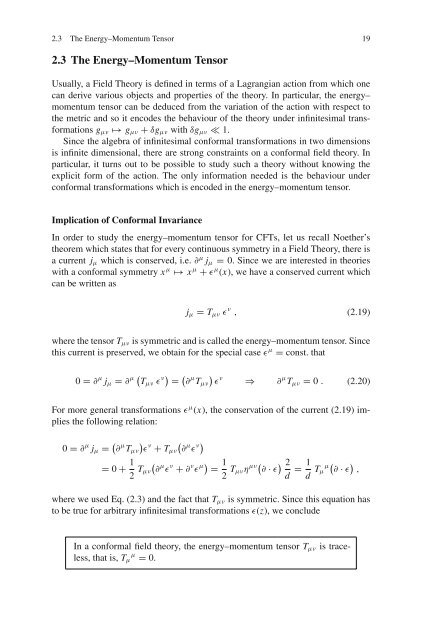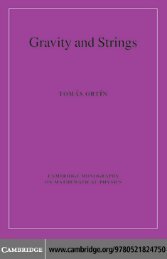- Page 2 and 3: Lecture Notes in Physics Founding E
- Page 4 and 5: R. Blumenhagen E. Plauschinn Introd
- Page 6 and 7: Preface These lecture notes are bas
- Page 8 and 9: Contents 1 Introduction ...........
- Page 10 and 11: Contents xi Concluding Remarks ....
- Page 12 and 13: 2 1 Introduction phase transition i
- Page 14 and 15: Chapter 2 Basics in Conformal Field
- Page 16 and 17: 2.1 The Conformal Group 7 ηρσ
- Page 18 and 19: 2.1 The Conformal Group 9 • The c
- Page 20 and 21: 2.1 The Conformal Group 11 transfor
- Page 22 and 23: 2.1 The Conformal Group z 13 ′ =
- Page 24 and 25: 2.1 The Conformal Group 15 z ↦→
- Page 26 and 27: 2.2 Primary Fields 17 • Since p(m
- Page 30 and 31: 2.4 Radial Quantisation 21 directio
- Page 32 and 33: 2.5 The Operator Product Expansion
- Page 34 and 35: 2.5 The Operator Product Expansion
- Page 36 and 37: 2.5 The Operator Product Expansion
- Page 38 and 39: 2.6 Operator Algebra of Chiral Quas
- Page 40 and 41: 2.6 Operator Algebra of Chiral Quas
- Page 42 and 43: 2.6 Operator Algebra of Chiral Quas
- Page 44 and 45: 2.6 Operator Algebra of Chiral Quas
- Page 46 and 47: 2.7 Normal Ordered Products 37 �
- Page 48 and 49: 2.7 Normal Ordered Products 39 The
- Page 50 and 51: 2.8 The CFT Hilbert Space 41 togeth
- Page 52 and 53: 2.8 The CFT Hilbert Space 43 for n
- Page 54 and 55: 2.9 Simple Examples of CFTs 45 S =
- Page 56 and 57: 2.9 Simple Examples of CFTs 47 Let
- Page 58 and 59: 2.9 Simple Examples of CFTs 49 c 1
- Page 60 and 61: 2.9 Simple Examples of CFTs 51 The
- Page 62 and 63: 2.9 Simple Examples of CFTs � L0
- Page 64 and 65: 2.9 Simple Examples of CFTs 55 Howe
- Page 66 and 67: 2.9 Simple Examples of CFTs 57 γ 0
- Page 68 and 69: 2.9 Simple Examples of CFTs 59 Radi
- Page 70 and 71: 2.9 Simple Examples of CFTs 61 whic
- Page 72 and 73: 2.9 Simple Examples of CFTs 63 Comp
- Page 74 and 75: 2.9 Simple Examples of CFTs 65 �
- Page 76 and 77: 2.9 Simple Examples of CFTs 67 �
- Page 78 and 79:
2.9 Simple Examples of CFTs 69 �
- Page 80 and 81:
2.10 Highest Weight Representations
- Page 82 and 83:
2.10 Highest Weight Representations
- Page 84 and 85:
2.10 Highest Weight Representations
- Page 86 and 87:
2.11 Correlation Functions and Fusi
- Page 88 and 89:
2.11 Correlation Functions and Fusi
- Page 90 and 91:
2.12 Non-Holomorphic OPE and Crossi
- Page 92 and 93:
2.12 Non-Holomorphic OPE and Crossi
- Page 94 and 95:
2.13 Fusing and Braiding Matrices 8
- Page 96 and 97:
Chapter 3 Symmetries of Conformal F
- Page 98 and 99:
3.2 The Sugawara Construction 89 wh
- Page 100 and 101:
3.2 The Sugawara Construction 91 c
- Page 102 and 103:
3.3 Highest Weight Representations
- Page 104 and 105:
3.3 Highest Weight Representations
- Page 106 and 107:
3.4 The �so(N)1 Current Algebra 9
- Page 108 and 109:
3.5 The Knizhnik-Zamolodchikov Equa
- Page 110 and 111:
3.5 The Knizhnik-Zamolodchikov Equa
- Page 112 and 113:
3.6 Coset Construction 103 Quotient
- Page 114 and 115:
3.6 Coset Construction 105 Hilbert
- Page 116 and 117:
3.7 W Algebras 107 where the first
- Page 118 and 119:
3.7 W Algebras 109 However, one sti
- Page 120 and 121:
Further Reading 111 N (N (LL)L) CWW
- Page 122 and 123:
114 4 Conformal Field Theory on the
- Page 124 and 125:
116 4 Conformal Field Theory on the
- Page 126 and 127:
118 4 Conformal Field Theory on the
- Page 128 and 129:
120 4 Conformal Field Theory on the
- Page 130 and 131:
122 4 Conformal Field Theory on the
- Page 132 and 133:
124 4 Conformal Field Theory on the
- Page 134 and 135:
126 4 Conformal Field Theory on the
- Page 136 and 137:
128 4 Conformal Field Theory on the
- Page 138 and 139:
130 4 Conformal Field Theory on the
- Page 140 and 141:
132 4 Conformal Field Theory on the
- Page 142 and 143:
134 4 Conformal Field Theory on the
- Page 144 and 145:
136 4 Conformal Field Theory on the
- Page 146 and 147:
138 4 Conformal Field Theory on the
- Page 148 and 149:
140 4 Conformal Field Theory on the
- Page 150 and 151:
142 4 Conformal Field Theory on the
- Page 152 and 153:
144 4 Conformal Field Theory on the
- Page 154 and 155:
146 4 Conformal Field Theory on the
- Page 156 and 157:
148 4 Conformal Field Theory on the
- Page 158 and 159:
150 4 Conformal Field Theory on the
- Page 160 and 161:
152 4 Conformal Field Theory on the
- Page 162 and 163:
154 4 Conformal Field Theory on the
- Page 164 and 165:
156 4 Conformal Field Theory on the
- Page 166 and 167:
158 4 Conformal Field Theory on the
- Page 168 and 169:
160 4 Conformal Field Theory on the
- Page 170 and 171:
162 4 Conformal Field Theory on the
- Page 172 and 173:
164 4 Conformal Field Theory on the
- Page 174 and 175:
166 4 Conformal Field Theory on the
- Page 176 and 177:
Chapter 5 Supersymmetric Conformal
- Page 178 and 179:
5.1 N = 1 Superconformal Models 171
- Page 180 and 181:
5.1 N = 1 Superconformal Models 173
- Page 182 and 183:
5.2 N = 2 Superconformal Models 175
- Page 184 and 185:
5.2 N = 2 Superconformal Models 177
- Page 186 and 187:
5.2 N = 2 Superconformal Models 179
- Page 188 and 189:
5.3 Chiral Ring 181 primaries, the
- Page 190 and 191:
5.3 Chiral Ring 183 always two comp
- Page 192 and 193:
5.4 Spectral Flow 185 � + ′ −
- Page 194 and 195:
5.5 Coset Construction for the N =
- Page 196 and 197:
5.5 Coset Construction for the N =
- Page 198 and 199:
5.6 Gepner Models 191 in moduli spa
- Page 200 and 201:
5.6 Gepner Models 193 S �so(10)1
- Page 202 and 203:
5.6 Gepner Models 195 Except the tw
- Page 204 and 205:
5.6 Gepner Models 197 Q � state
- Page 206 and 207:
5.6 Gepner Models 199 Before perfor
- Page 208 and 209:
5.7 Massless Modes of Gepner Models
- Page 210 and 211:
Further Reading 203 (3, −3, 0) (2
- Page 212 and 213:
Chapter 6 Boundary Conformal Field
- Page 214 and 215:
6.1 The Free Boson with Boundaries
- Page 216 and 217:
6.1 The Free Boson with Boundaries
- Page 218 and 219:
6.1 The Free Boson with Boundaries
- Page 220 and 221:
6.2 Boundary States for the Free Bo
- Page 222 and 223:
6.2 Boundary States for the Free Bo
- Page 224 and 225:
6.2 Boundary States for the Free Bo
- Page 226 and 227:
6.2 Boundary States for the Free Bo
- Page 228 and 229:
6.2 Boundary States for the Free Bo
- Page 230 and 231:
6.2 Boundary States for the Free Bo
- Page 232 and 233:
6.3 Boundary States for RCFTs 225
- Page 234 and 235:
6.3 Boundary States for RCFTs 227 T
- Page 236 and 237:
6.4 CFTs on Non-Orientable Surfaces
- Page 238 and 239:
6.4 CFTs on Non-Orientable Surfaces
- Page 240 and 241:
6.4 CFTs on Non-Orientable Surfaces
- Page 242 and 243:
6.4 CFTs on Non-Orientable Surfaces
- Page 244 and 245:
6.4 CFTs on Non-Orientable Surfaces
- Page 246 and 247:
6.5 Crosscap States for the Free Bo
- Page 248 and 249:
6.5 Crosscap States for the Free Bo
- Page 250 and 251:
6.5 Crosscap States for the Free Bo
- Page 252 and 253:
6.6 Crosscap States for RCFTs 245 w
- Page 254 and 255:
6.6 Crosscap States for RCFTs 247
- Page 256 and 257:
6.7 The Orientifold of the Bosonic
- Page 258 and 259:
6.7 The Orientifold of the Bosonic
- Page 260 and 261:
6.7 The Orientifold of the Bosonic
- Page 262 and 263:
6.7 The Orientifold of the Bosonic
- Page 264 and 265:
Concluding Remarks Let us conclude
- Page 266 and 267:
Index A A-D-E classification, 148 a
- Page 268 and 269:
Index 263 Klein bottle partition fu
- Page 270:
Index 265 simple current, 161 summa




